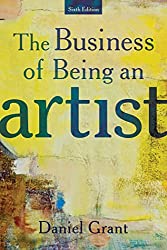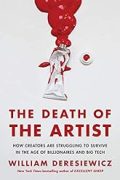
Rating: 7.2/10.
Book about the business side of art. Ideally, your art would be displayed in a gallery where people will buy it, but galleries themselves face intense economic pressures and they need to sell most of their art in order to break even. Therefore, most artists need to do a lot of thinking like a businessman, such as networking with potential buyers of their type of art, doing social media, reaching out to writers and bloggers, and setting up websites with a good public image.
There are a lot of not so obvious places to display artwork, including festivals, college art galleries, regional museums, artists, own studios, hospitals and hotels, etc. A lot of them serve to get exposure for the artist more than to sell art. When talking to you potential buyers, be professional and be willing to talk about art to non-experts without getting offended. Steer the conversation in a positive direction when asked basic questions like “how long does it take to make the art?”
Some ways to make money other than selling art: licensing art to use in commercial products is one way, allows you to collect royalties for some time after, depending on how well the product sells. When selling prints, it’s good to have a certificate of authenticity to limit the supply. Another is renting out art instead of selling, although there is a risk of the art getting damaged or the renter not giving it back. This is especially risky when dealing with renters in other countries because of foreign laws and getting it back is even harder.
Artists often partnered with dealers to handle the business side of things, typically they take a 50% cut (which may be unfair if the art is expensive to produce). Often the relationship goes sideways: dealers don’t pay the artist or don’t return unsold work, and the legal system is so expensive that artists have no recourse other than beg and hope for the best. In some situations, mediation is a cheap alternative to suing. Various legal issues can involve artists: disagreements between the artist and the dealer as mentioned, also buyer modifying the artwork in a way that the artist dislikes; depiction of copyrighted logos in art (eg: painting of Times Square); art that is too similar to other artists’ work (here there is a large gray area of fair use law).
Most artists struggle to find a job after finishing art school. One way to improve your skills while making some money is to become an assistant of an already established artist – this will teach you skills but they typically don’t want you copying their style. Teaching is another way, sometimes can run into issues where art becomes controversial, but also, some people find that teaching is more rewarding than making art. Artist in residence programs (in museums, galleries, schools, etc) offer some facilities for the artist in exchange for teaching and community work. Artist often use materials that toxic and require special ways to dispose of environmentally; they may cause obscure health problems that are hard to diagnose.
Artists have many difficult periods in their life, such as the feeling of nothingness when a major exhibition is finished, handling criticism, dealing when your art becomes controversial, problems with your spouse who is also likely to be an artist, etc. When an artist dies, typically the value of their art decreases since the artist cannot do the work of selling it. However, problems arise when the tax authorities and descendants can’t agree on how much the remaining art is worth.
Overall, I felt the tone of this book was overwhelmingly negative: it’s essentially a list of everything that could go wrong in an artist’s career or personal life. About half the chapters are related to business of art (it’s sort of assumed that artists are bad at business and want to focus on their art, yet business is a crucial aspect of becoming successful); the other half are assortment of ways that people can screw you over: your dealer, galleries, other artists, lawyers. your spouse, etc, and there is fairly little positive things that the author has to say about this subject. It is generally stereotyped that becoming an artist is not an especially lucrative career, and this book hammers home all the other problems with being an artist that you might not have thought about.



